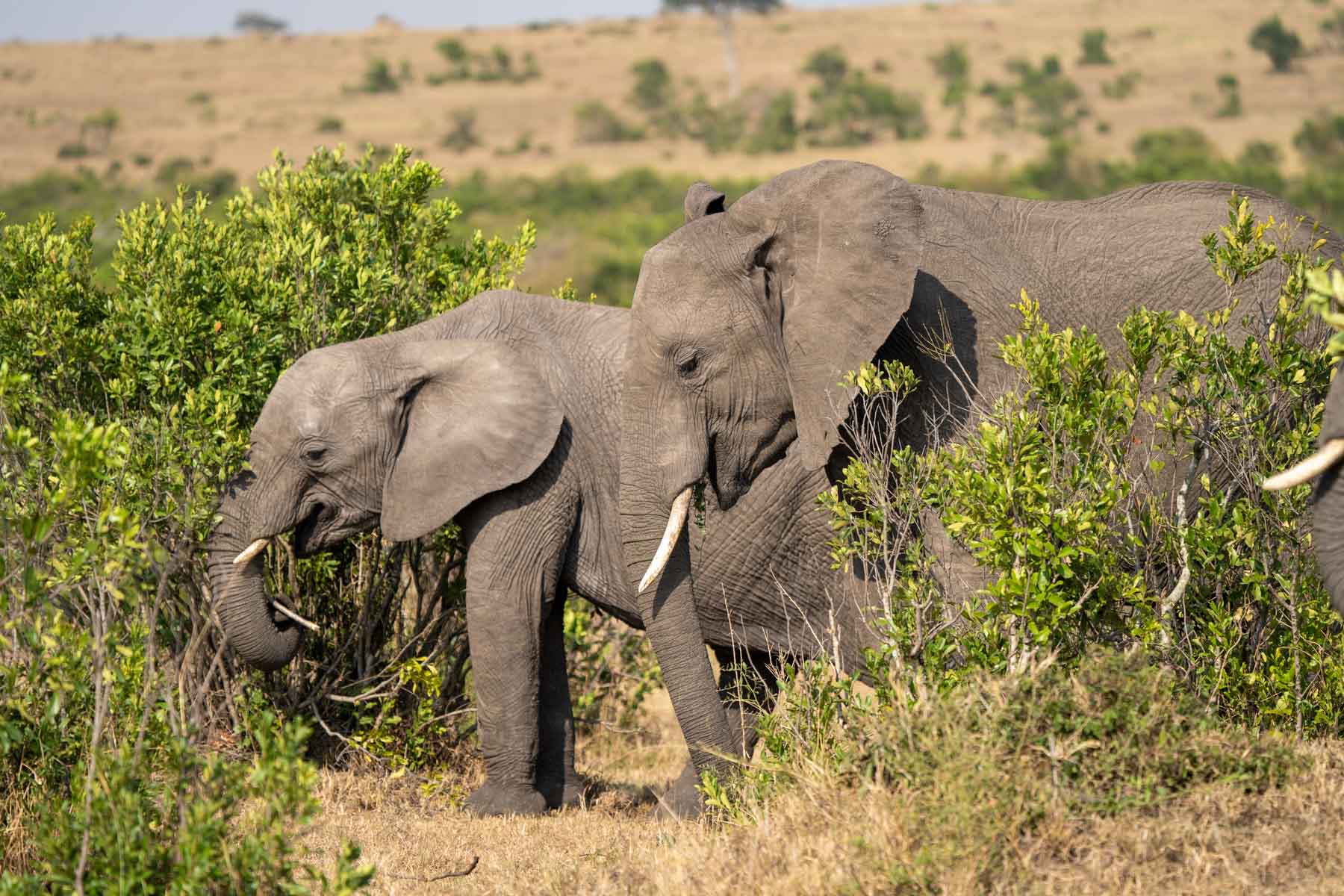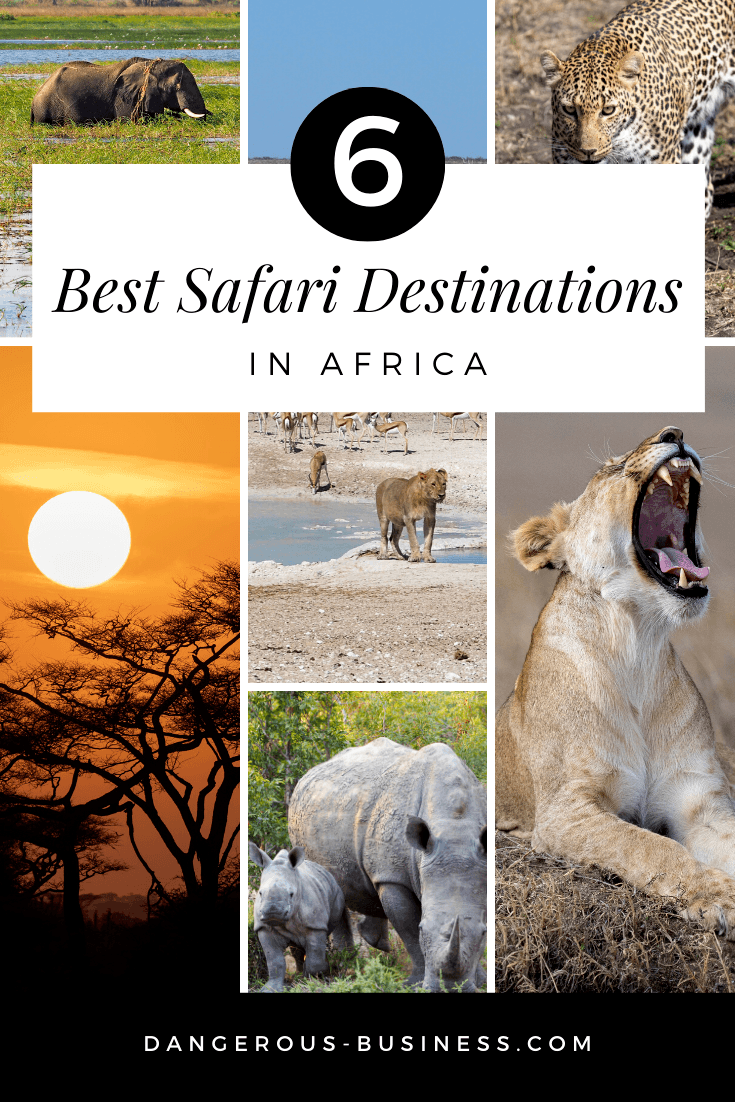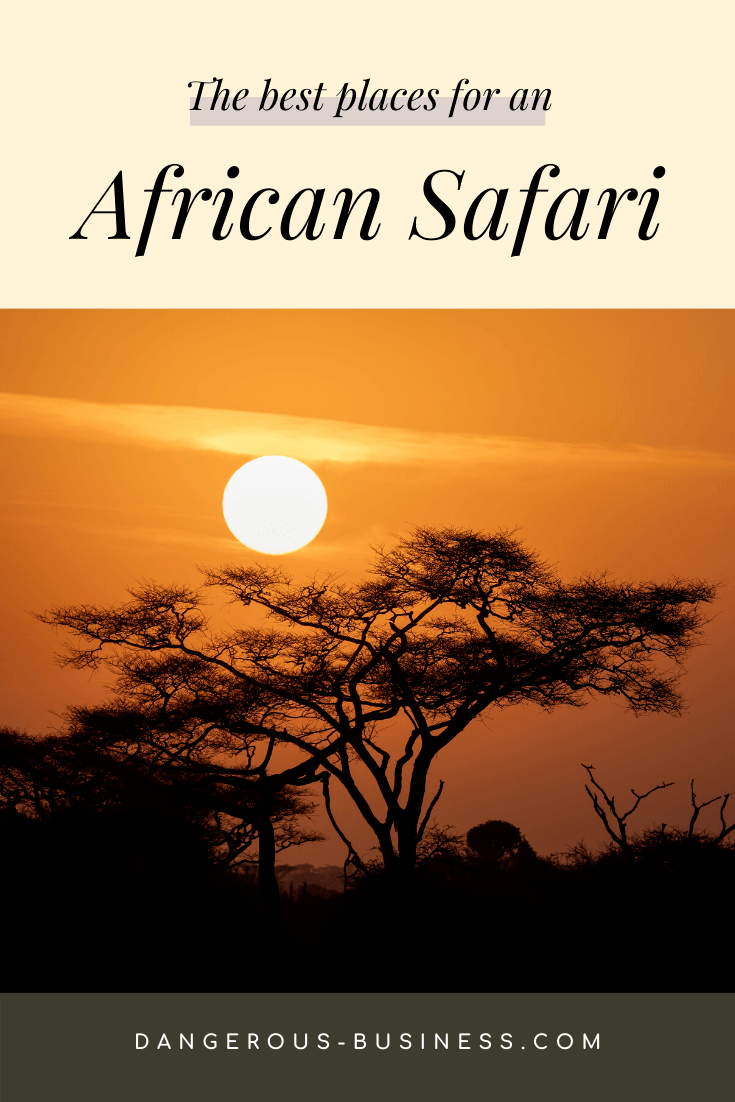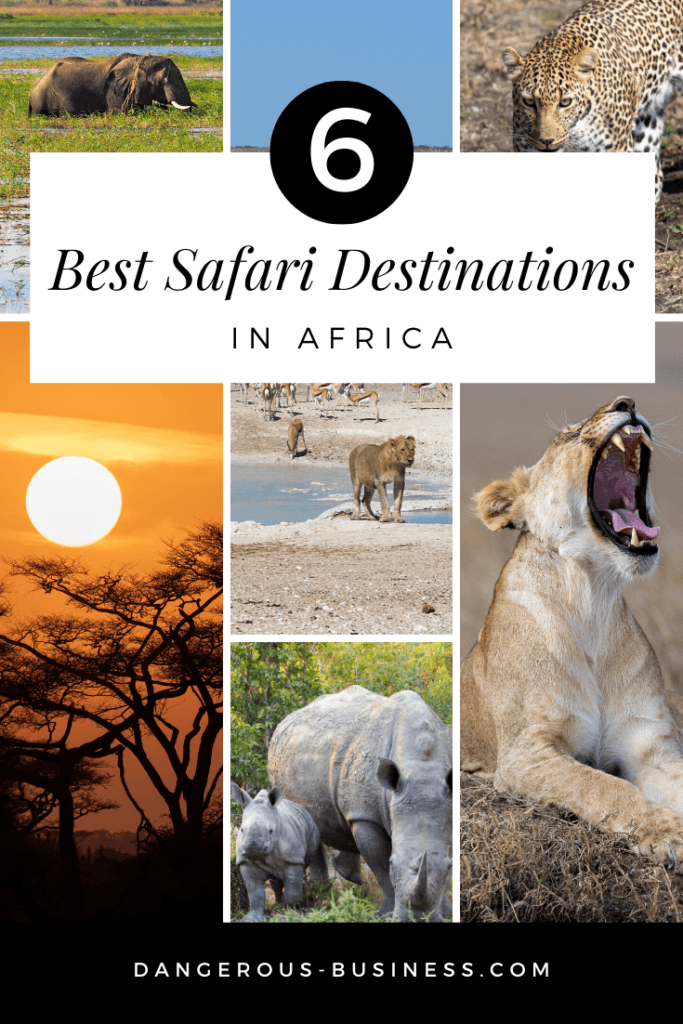6 of the Best Places to Go on Safari in Africa

When it comes to travel bucket lists, “going on safari in Africa” is an item that appears on many of them. And understandably so – seeing things like elephants and lions and hippos in their natural wild habitats is magic; going to the zoo is never the same again.
I've been lucky enough to go on several safaris in a handful of different countries on the African continent. Each African safari has varied in everything from terrain to wildlife sightings, but they've all been incredible.


Being able to pinpoint the best safari in Africa is probably impossible since it's so subjective, but this is such a bucket list item for so many people. Hopefully my detailing some of my favorite places to go on safari in Africa (so far) can help you narrow down the options when you plan your own trip.
The best parks for safaris in Africa
(Based entirely on where I've personally been on safaris!)
1. Kruger National Park
South Africa

My very first safari was in Kruger National Park in South Africa. Covering more than 7,500 square miles (nearly 19,500 square kilometers), Kruger is one of the largest game parks in Africa. It's also an excellent place for a first safari since it's easily accessible.
Kruger fun fact: It was the first national park created in South Africa in 1926.
How I experienced it: My safari experience in Kruger National Park was a luxurious one; we stayed in a private concession within the park (the Jock Safari Lodge), slept in a fancy mini-villa, and went on multiple game drives per day. Because we were staying at a private game lodge, we went mostly off-road on our safaris and very rarely saw other vehicles; the park never felt “crowded.”

RELATED: The Private Game Lodge Experience in Kruger National Park
Other ways to experience it: You can also self-drive and camp within Kruger, though if you're driving yourself you have to stay on dedicated park roads.
Kruger landscape: Kruger is a relatively flat park with plenty of trees and bushes for animals to hide in. You'll find lots of thorny acacia trees and red-bush willow, and some areas of dense vegetation.

What you can see in Kruger National Park: You can see just about everything in Kruger, from the Big 5 (buffalo, elephant, rhino, lion, and leopard) to hyenas to giraffes to even wild dogs if you're lucky.
Most unique thing to see: We saw a pack of wild dogs trying to chase away a pack of hyenas. There are thought to only be about 400 wild dogs in the whole of South Africa, so if you manage to spot some in Kruger it's very special.

The best time to visit Kruger: The rainy season in Kruger runs from September through April, and the dry season from May to September. The “best” times to visit are usually in between the two seasons: in April/May and in September, when temperatures are mild. I visited in May, and the weather was mostly dry with warm days and cool nights.

How to get there: Flights operate between major cities in South Africa and either the Kruger Mpumalanga International Airport or Skukuza Airport, both near the south part of the park. You can also drive to Kruger from Johannesburg in 4-5 hours.
2. Serengeti National Park
Tanzania

The Serengeti often represents the epitome of the African safari experience for many people. It's the park shown in so many nature specials, and of course the park represented in classics like “The Lion King.” And it's a great park for an epic safari.
Serengeti fun fact: While the Serengeti isn't even close to being the largest national park in Africa, it still covers 5,700 square miles (14,750 square kilometers). The name “Serengeti” in the local Maasai language translates to “endless plain.”

How I experienced it: I went on a multi-day safari to both the Serengeti and Ngorongoro Crater in Tanzania. We spent one night camping at one of the park's public campsites in the south of the Serengeti. The campsite was basic (cold water showers, but also real toilets) and unfenced, meaning it's not uncommon for animals to stroll through camp – we heard hyenas! The sky at night was amazing.

Other ways to experience it: The Serengeti is huge, and there are plenty of alternatives to basic camping, from luxurious lodges to comfortable tented camps. Some popular spots to check out include Melia Serengeti Lodge, Kiota Camp, and Serengeti Serena Safari Lodge. Check out more suggestions on where to stay here.
Serengeti landscape: The Serengeti is usually know for its plains, which are mostly grass and broken up only by the occasional tree or rock formation. There are two other major sections of the park, though: the Western Corridor (home to the Grumeti River), and the Northern Serengeti, which is hillier and ends at the Mara River on the Kenya border.
What you can see in Serengeti National Park: Pretty much everything! It's most known for its huge herds of wildebeest and zebra, which migrate from the Serengeti to the Maasai Mara and back again each year to literally follow greener pastures. Along with the herd migrations, the Serengeti is also great for seeing big cats and birds.


Most unique thing to see: Probably the wildebeest migration, but also calving season, which takes place in the central and southern Serengeti in January/February. During this time, thousands of wildebeest are born every day!
The best time to visit the Serengeti: The experience in the Serengeti can vary wildly depending on which season you visit in. Dry season is June-October, and usually the busiest – it's also when the Great Migration happens. I visited in the dry season in August, which was good for seeing things like big cats hunting, but also SUPER dry and dusty. March-May are usually the rainiest months, but also when you can get the best deals.

How to get there: Most people will visit the Serengeti as part of a longer safari trip. Most of these safaris start in Arusha, Tanzania; from there, it's 3-4 hours to one of the Serengeti entrance gates. Arusha is served by Kilimanjaro International Airport.
RELATED: East Africa Highlights: Kenya and Tanzania with Rock My Adventure
3. Ngorongoro Crater
Tanzania

One of my favorite safaris took place inside the Ngorongoro Crater in Tanzania's Ngorongoro Conservation Area. The massive conservation area is right next to Serengeti National Park, but the crater itself could not be more different.
Millions of years ago, a volcano likely larger than Mount Kilimanjaro erupted (well, more like exploded), leaving behind what is today called the Ngorongoro Crater. The Crater is 2,000 feet (610 meters) deep, and its floor covers 100 square miles (260 square kilometers); it's one of the largest inactive, intact volcanic calderas in the world. And you can go on safari inside it.


Ngorongoro Crater fun fact: Most of the wildlife living inside the Crater never leaves. Not because it's fenced in or anything, but because that 100 square miles of caldera floor contains everything the animals could possibly need. You can explore most of the Crater in a day.
How I experienced it: I visited the Ngorongoro Crater as part of a multi-day safari in Tanzania that included visiting the Serengeti. It was a camping safari, and we used the Ngorongoro Simba Campsite on the crater rim. The campsite had basic facilities (Western toilets and mostly cold showers), and was unfenced, meaning animals wandered through frequently.
Other ways to experience it: There's nowhere to stay inside the Crater itself, but there are several luxury lodges that overlook it, like the andBeyond Ngorongoro Crater Lodge or the Neptune Ngorongoro Luxury Lodge.

Ngorongoro landscape: Inside the Crater, it's a mix of grasslands and bush, with a small forested section, and a central salt lake. And of course you can always see the steep, forested crater walls, too.
What you can see in the Ngorongoro Crater: The Ngorongoro Crater is home to the Big 5 (including a large number of lions), jackals, cheetahs, and herds of zebra and wildebeest. You'll also find plenty of hippos! The only animals you're not likely to see inside the crater itself are giraffes, as they have trouble walking down the steep slopes into the Crater.


Most unique thing to see: The Ngorongoro Crater is home to a couple dozen endangered black rhinos. It's rarer and rarer to see them these days since they are being so well-protected, so spotting one would be a treat (I didn't see any rhinos!).
The best time to visit the Ngorongoro Crater: Wet season in the Crater stretches from November to May, and this is when it's the most lush. The best wildlife viewing months are generally June-September in dry season, but this is also when it's busiest. If you want less crowds, the end of rainy season (April/May) is usually recommended – just pack a rain jacket.

How to get there: The majority of people will reach the Ngorongoro Crater by car; it's roughly a 3-hour drive from Arusha, Tanzania, and Arusha is served by Kilimanjaro International Airport. Chances are a visit to the Crater will be part of a larger safari package.
4. Maasai Mara National Reserve
Kenya

The Maasai Mara in Kenya is a great safari destination since you can blend the wildlife viewing experience with some cultural visits to local Maasai villages, too. The Mara offers up a well-rounded experience in Kenya.
Maasai Mara fun fact: The Maasai Mara is connected to the Serengeti across the border in Tanzania. The Great Migration takes place between the two parks.
How I experienced it: I stayed for 3 nights at the Mara Explorers Camp, a backpacker spot with cabins and campsites close to the park entrance. The vibe at this place is great, and they can organize game drives in the park with local Maasai guides. We did a full-day game drive in the reserve on our first day, and on the second day visited a local village to learn more about Maasai culture and life.

Other ways to experience it: Since the Maasai Mara is one of the most popular spots in Kenya, it's well developed for luxury tourism, too. Luxury tented camps are popular here – but don't worry, there's nothing about these camps that say “camping!” Tented camps I looked at when planning my trip included Little Governor's Camp, Kandili Camp, and Olarro (the last one is super luxurious!).
And if you've always dreamed of seeing the African plains or the Great Migration from a hot air balloon, this is the place to take a flight. It's not cheap ($450 per person), but it's even more expensive in the Serengeti. Flights in the Mara include pickup at your accommodation, a 1-hour balloon flight, champagne breakfast in the reserve, and then a game drive back to your lodge.


Maasai Mara landscape: The landscape of the Mara is gently rolling with light vegetation – not as much as in Kruger, but far more than in the Serengeti. The word “mara” in the local Maasai language means “spotted,” reflecting the fact that the area is dotted with acacia trees and dips in the land. Most game drives in the Mara take place in the Central Plains (the largest part of the reserve) and the Mara Triangle (bordering the Mara River).
What you can see in the Maasai Mara: The Mara is populated by tons of wildebeest and zebras, large numbers of hippos, and big cats (especially lions). You can also spot Nile crocodiles in the Mara River, plenty of giraffes, hyenas, elephants, and more than 470 species of birds. I was even lucky enough to see a serval cat here!



Most unique thing to see: Seeing wildebeest and zebras cross the Mara River during the Great Migration is what everyone hopes to see.
The best time to visit the Maasai Mara: The best months for wildlife viewing are usually June-October (dry season), with January and February also being okay and usually not quite so busy. The Great Migration usually takes place July-September, though of course you can never predict those river crossings.


How to get there: You can reach the Maasai Mara by either road or flight from Nairobi. Driving takes about 5 hours, and the roads aren't always great, especially the further away from Nairobi that you get. Flights take about an hour from Nairobi, and there are also links to other destinations in Kenya.
5. Chobe National Park
Botswana

If it's elephants you love, then you absolutely need to put Botswana's Chobe National Park on your must-visit list. Chobe covers 4,500 square miles (11,700 square kilometers) in northern Botswana. It was Botswana's first national park, and is known for having a lot of wildlife.
This park offers up some unique ways to view the wildlife, too, including boat tours that get you right up close with hippos and swimming elephants.
Chobe fun fact: Chobe is known for its large elephant population, which some estimates put around 50,000. This is the largest elephant population on the African continent.
How I experienced it: I visited Chobe as part of an overland trip through southern Africa. We stayed at a campsite (Thebe River Lodge) near the park in Kasane, and then did two game drives: one in a vehicle, and another in a boat on the Chobe River, both organized through our accommodation.

Other ways to experience it: Botswana has become known for its luxury safari options; in fact, the country purposefully targets this kind of travel. Some luxury lodges near Chobe to consider include Ghoha Hills Savuti (top-rated on TripAdvisor), and the Ngoma Safari Lodge.
Chobe landscape: Chobe National Park is made up of roughly three sections, all revolving around water. There's the Chobe riverfront along the northeast border of the park, where you'll find floodplains and wooded areas; the Savuti Marsh area in the west of the park, which is more savannah-like; and the Linyanti Marsh in the northwest.
What you can see in Chobe National Park: Elephants, of course! And also plenty of hippos, lions, birds, and other animals. But you really come here for the elephants.


Most unique thing to see: The most interesting thing I saw were swimming elephants! You don't usually think of these giants taking to the water, but they totally do. We even saw an elephant completely submerge itself, flip over, and use its trunk like a snorkel!

The best time to visit Chobe National Park: May to October is dry season in Chobe, and the best time for wildlife viewing. During the dry season, many animals congregate around the Chobe River and other watering holes, making sightings frequent and easy.
How to get there: The most-visited part of Chobe National Park is the riverfront area. The entrance to this part of the park lies conveniently just 3 miles away from the city of Kasane, which is only about 50 miles away from Victoria Falls. You can fly into Kasane Airport for easy access, or the drive from Victoria Falls is only about an hour.
RELATED: Enchanted by Chobe National Park in Botswana
6. Etosha National Park
Namibia

The other parks and reserves on this list are some of the biggest names for safari in Africa. But I wanted to add one more that I personally loved, but that I don't think usually gets the attention that it deserves!
Etosha National Park covers 8,600 square miles (22,270 square kilometers) in northwestern Namibia and has been a game reserve for more than 100 years.
Etosha fun fact: The park is named after the Etosha Pan, which is a massive salt pan located almost entirely within the national park.

How I experienced it: I visited Etosha on my overland trip, where we self-drove through the park during dry season in our overland vehicle. Self-driving is actually the most popular way to see Etosha, and is pretty easy because of the park's good road system. We camped inside Etosha at the Okaukuejo Camp, which also offers more traditional rooms that overlook a floodlit watering hole – we saw tons of wildlife without ever leaving camp!
Other ways to experience it: I personally loved staying at one of the camps within the park, but if you're looking for something slightly more luxurious, you can also check out places like Onguma Tented Camp or Ongava Lodge.

Etosha landscape: Etosha is basically made up of the large, flat, silvery Etosha Pan (covering 1900 square miles), and a series of watering holes. You can also visit the Dolomite Hills on the southern border of the park.
What you can see in Etosha National Park: Etosha has lots of wildlife, including the big cats, elephants, giraffes, oryx, hyenas, and more. During the dry season, it's fun to see how many different species you can spot around the watering holes.


Most unique thing to see: Etosha has a (relatively speaking) large population of black rhinos – this is the only place in Africa where I was lucky enough to see one!

The best time to visit Etosha National Park: Dry season (May-October) is the ideal time to visit Etosha. The months of July-September are the most popular, when animals tend to gather around watering holes and when temperatures are fairly mild.
How to get there: Etosha is located 270 miles (435 milometers) north of the Namibian capital of Windhoek. While driving to Etosha from the capital takes about 6 hours, this is the most popular way to reach the park.
RELATED: Overlanding in Southern Africa: Everything You Need to Know
Honorable mention: Okavango Delta
Botswana

I also need to mention the Okavango Delta here, and the Moremi Game Reserve (the only protected area of the Okavango Delta). This spot is so unique within Botswana (and Southern Africa as a whole), and should definitely be on your must-visit list.
The only reason why it's not officially included on this list is that it's less of a safari destination and more of an overall experience.
Visiting the Okavango Delta usually includes a ride in a mokoro (a narrow dug-out canoe) along the Delta's waterways, and can also include walking safaris, overnight stays in tented campsites, and even doors-off helicopter rides.


Animals you can expect to see in the Okavango Delta include elephants, hippos, leopards, and hoofed animals like zebras and wildebeest.
READ MORE: The Okavango Delta Three Ways: By Foot, Boat, and Air
Still on my bucket list
I haven't visited *every* game park in Africa, folks. There are still several that are on my to-do list – and I'm sure some of these will ultimately make my list of the best safari parks, too!
National parks and reserves I still want to visit for wildlife include:
- Volcanoes National Park/Bwindi Impenetrable National Park, Rwanda/Uganda – I would love to visit either of these national parks in order to trek to see the mountain gorillas.
- Queen Elizabeth National Park, Uganda – Uganda's most-visited national park is known for its chimpanzees and tree-climbing lions.
- Amboseli National Park, Kenya – Known for its elephant herds and views of Mount Kilimanjaro.
- South Luangwa National Park, Zambia – Famous for walking safaris and leopard sightings.
- Hwange National Park, Zimbabwe – Zimbabwe's largest reserve is known for its elephants, big cats, and wild dogs.
- Madagascar National Parks – And of course I'd love to visit some of the national parks in Madagascar (like Andasibe-Mantadia National Park and Ranomafana National Park) to see lemurs!
READ NEXT: 8 Things to Know Before Going on Your First African Safari
Have you been on safari in Africa? If so, where have some of your favorite wildlife sightings taken place? If not, which park would you choose for your first safari?
Pin it for later:



Amanda Williams is the award-winning blogger behind A Dangerous Business Travel Blog. She has traveled to more than 60 countries on 6 continents from her home base in Ohio, specializing in experiential and thoughtful travel through the US, Europe, and rest of the world. Amanda only shares tips based on her personal experiences and places she's actually traveled!











Africa is too beautiful to truly explain. The Okavango has been a dream of mine for years. Thanks for not only sharing the sites but also the transportation and the lodging. Keep it up!
Loved reading your safari blog. I’ve done a safari in the Serengeti and Crater, and have never gotten to the Serengeti in less than 5 hours. Also just an FYI the other reason there are no giraffes in the Crater is there aren’t any acacia trees, so there isn’t a food a source.
I know this is an impossible questions to ask, but do you have a favorite Sub-Saharan African experience? I am planning to go in the (likely distant, given covid) future, mainly for safari but also for a cultural experience. Whenever I’m planning someplace new your blog is one of the first places I check for inspo and ideas (I’ve done a lot of things that you’ve recommended and it’s always been a positive experience) but you have me wanting to go everywhere in Sub-Saharan Africa and I just don’t have the vacation days for that lol. South Africa seems cool because everyone loves Cape Town in addition to the national parks. Botswana seems to have commendable conservation efforts and I love elephants. Tanzania has the scenery that I think I envisioned for a safari (likely based on The Lion King) and Zanzibar seems like a nice place to relax after safari-ing. Kenya seems to have similar scenery to Tanzania, also has commendable conservation efforts, and Nairobi has the giraffe and elephant rescues (although I’m sure rescues are prevalent everywhere). Sorry this got long….but did you walk away with any strong preferences after your safari experiences? Thanks!
That IS a really tough call! A lot of people like South Africa because it’s more “familiar” feeling for anyone coming from Europe or North America, and has a nice mix of cities, coast, wine country, and of course the safari options. If you’re more interested in the wildlife, Tanzania has such a great variety, plus is close to Zanzibar (which, yes, makes for a great end to a trip!). It’s also easy to pair up Tanzania and Kenya. For South Africa, though, I would probably just stick to that country if you have 2 weeks or less to travel.
They say nothing good comes out of Africa because every good remains in Africa. period. Uganda , Gifted by Nature.
I like that quote! I definitely hope to visit Uganda one day.
Ngoro Crater in Tanzania was my fav. It’s such a cool ecosystem where animals are stuck in there and can’t get out!
It’s not that they can’t get out – they’re not fenced in or anything! It’s just that there’s really no reason for them to leave!
I’ve only been on two safaris in Africa both of them were self-drive and pretty underwhelming. My favourite was the Tsitsikamma National Park in South Africa. I’ve done more safaris in other countries, so I really have to make my way back to Africa to explore more the different countries and their wildlife!
Self-drive safaris are usually more affordable, but there’s definitely something to be said of having a local driver/guide who knows where to look and who can quickly get you to where things are happening!
Africa has a great wildlife. Every animal lover should visit Africa once.
I agree! There’s a reason it’s a bucket list trip for so many people.
In love with your photos. ?